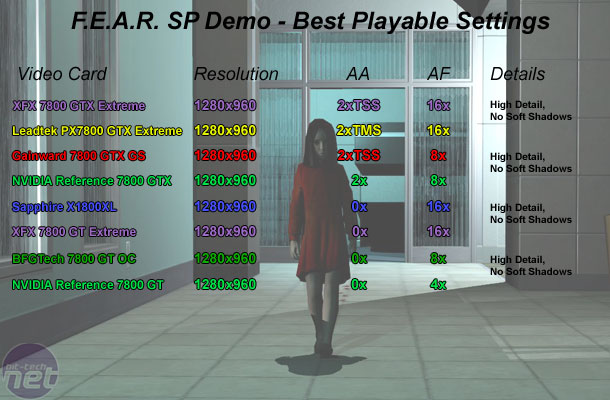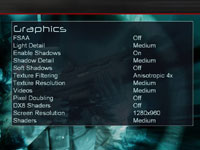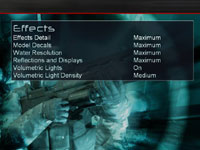7800 GTX Extreme Edition Head-to-Head
October 20, 2005 | 11:04

F.E.A.R. - single player demo
Publisher: VU GamesWe used the F.E.A.R. public demo, as it is on course to become the most intensive shooter of 2005. The game makes use of a lot of effects - including soft shadows, volumetric lighting, parallax mapping and particle effects, along with a slow-motion mode that really taxes today's top of the line GPU's. There's extensive use of high resolution textures. The walls are both bump mapped and parallax mapped to give a realistic feel to the brick walls that are a big feature of this title. Also, the world is incredibly destructible, which is made more realistic by parallax mapping.
In general, this is a graphically intense game and the most outstanding part of the graphics engine is undoubtedly the player character's shadow that is cast on the wall.
It also has the most advanced A.I. that we have ever seen in a game engine to date - there are times when you'll find yourself with your pants down around your ankles with no where to go. For anyone who hasn't played this demo yet, it's well worth a look - check out our F.E.A.R. preview here.
Anti-Aliasing and Anisotropic Filtering were controlled from inside the game, and thus drivers were left set to "Application Controlled".
Below is a table of the best-playable settings that we found best for each video card configuration. We decided that a minimum frame rate of around 15 frames per second and an average of over 45 frames per second would deliver a good gaming experience on these mid-range cards. This was not what we would call creamy smooth gaming, but it was about as smooth as possible given the issues we were having in achieving smooth game play with 1GB of memory.

We found that we were able to run at higher in-game settings on XFX's Extreme Gamer Edition in comparison to both the Leadtek Extreme Edition and Gainward's Golden Sample. Both the XFX and Gainward were able to deliver a good gaming experience at 1280x960 with 2x transparency supersampled Anti-Aliasing. However, we found that the slightly lower core speed on the Gainward 7800 GTX Golden Sample meant that we had to lower the Anisotropic Filtering from 16x to 8x in order to attain acceptable game play.
Leadtek's PX7800 GTX TDH Extreme Edition did not have enough memory bandwidth available to it to enable us to utilise transparency supersampled Anti-Aliasing, and we had to settle for transparency multisampled Anti-Aliasing. However, we were able to play the game with 16xAF without any hitches, meaning that the filtering was slightly better than what was playable on Gainward's GTX Golden Sample. We'd say that the highest playable image quality delivered by the Leadtek and Gainward GTX's was about a draw - the positives balanced out the negatives.
Finally, the NVIDIA Reference 7800 GTX was not able to utilise transparency Anti-Aliasing without hitching problems during intense firefights. We also found that we had to use 8xAF, much like what we had to use on the Gainward 7800 GTX Golden Sample. The reference GTX also delivered an average frame rate that was nearly 5 frames per second lower than what we saw on the three overclocked GTX's.

MSI MPG Velox 100R Chassis Review
October 14 2021 | 15:04








Want to comment? Please log in.